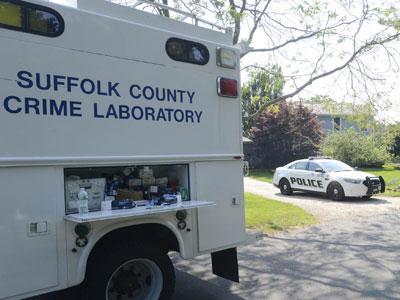The Must-Haves
The Must-Haves
These days the quintessential Hamptons house requires certain amenities. Gym? Check. Wine cellar? Of course. En-suite bathrooms? Naturally.
No self-respecting builder would erect a South Fork house without those perks and then some. What might be considered over the top anywhere else is de rigueur here.
Alan Schnurman doubles as both a broker at Saunders and a “spec builder” who designs houses on the dictates of the market. After all, he wants to be sure they sell. “If you don’t put everything in, they’ll say, ‘I love your house, but if you only had a guest master. . . .’ Whatever you don’t have, that’s what they want.”
So he’s taking no chances as he builds a house on a 45-acre reserve off Hedges Lane in Sagaponack. On the lower level (no longer called a basement), built to the same standards as the upper levels, is a 36-by-16-foot gym, two bedrooms and two full baths (for help), steam shower, “full entertaining kitchen” that includes “everything but a stove,” recreation area with fireplace, billiard room, media room, wine cellar, and . . . drum roll here . . . elevator. “I would not build a house without an elevator,” he said.
The upstairs also reflects today’s Hamptons house must-haves. The kitchen will boast two dishwashers, a high-end stove (probably a Wolf or Viking with matching hood and six to eight burners), a huge middle island with two sinks, a fireplace, a breakfast area overlooking the deck, and a butler’s pantry with wine cooler and refrigerator drawers. Not to mention another butler’s pantry between the dining room and kitchen.
In keeping with the fashion to have an open-plan living space, the kitchen faces a family room and living room with only half-walls to demarcate them as separate rooms. “You can actually see 70 feet from the kitchen to the fireplace in the living room,” said Mr. Schnurman. To complete the first floor is a “junior master bedroom,” which Mr. Schnurman claims is “a must for people who have parents.” Despite the elevator, he believes older family members prefer not to make the upstairs trek.
All bedrooms have en-suite baths, while the master bedroom has a 170-square-foot walk-in closet (bigger than a typical Manhattan kitchen) and two balconies. The master bath has the usual oversize shower and tub, balcony, and — what Hamptons bathroom would be complete without them — his and hers W.C.s. Naturally, there’s another living room over the garage, guest suites being essential.
“Nobody wants just a house anymore,” said Julie Keyes, an art dealer who moonlights as an agent at Saunders in Bridgehampton. “They want a compound.” Hamptonites want friends and family to visit, but “they don’t want them to live in the house.” So, while guest wings are fine, guesthouses are preferable, she believes. Though, it must be noted, there are many guest wings where inhabitants are given all they need to stay independent, and which make staying at a Taj hotel seem like slumming. Many homeowners, said Ms. Keyes, are converting pool houses into guest quarters. Gyms too are fine, she said, but yoga rooms are better. She mentioned one health-conscious celebrity who has a “yoga building.”
Pamela Glazer, a Southampton architect, observed that East Enders are filling their houses with things that once were left to commercial spaces. “Everybody wants a media room,” she said, whether it’s just a closed off space with a large screen TV, sofa, and sound system or a step-down theater with rows of leather recliners. You know it’s a ubiquitous trend when a store such as P.C. Richard sells several styles of movie seats, even though, as Ms. Keyes said, “I can see a producer needing one, but even dentists feel they need a screening room. . . . They don’t care that no one’s ever going to use it. . . . It’s the modern equivalent of a guitar in the closet.”
One screening room that has seen lots of use for entertaining Hollywood bigwigs, including Kevin Costner, who screened one of his films there, is the 110-seat space at Goose Creek, a five-plus-acre estate in Wainscott. The asking price of that house was just lowered from its original $26 million to $10.9 million.
Ms. Glazer also sees amenities that are usually reserved for restaurants or bars making inroads in houses, citing “game rooms with full bars, pool tables, Ping-Pong, and dart boards,” and kitchens with restaurant stoves and glass-fronted fridges. “We’re almost antisocial or just want to socialize with who we want to be with,” she mused. For a homeowner who spends a few weeks a year in a house, “it’s not like they need to spend $12,000 on a refrigerator.”
But she can see the value of a big kitchen island, noting that a lot of Hamptons denizens emigrate from the city with their busy lives and miniscule kitchens and use these central anchors as gathering places where hosts and guests can cook and socialize.
Perhaps the most recent trend, according to Town and Country's Judi Desiderio, is the moving of kitchens outside. Brown Jordan Outdoor Kitchens offers “a wide-range of cooking and entertaining possibilities that rival interior kitchens” according to an ad. No kidding. The builder Jeffrey Collé has just built an outdoor kitchen that is more elaborate than most indoor kitchens, what with its grills, burners, warming drawers, refrigerator drawers, wine cooler, deep fryer, and even pizza oven. “Barbecues have reached a whole new dimension,” he said. An understatement to be sure.
Outdoor living rooms have also become popular. “People get to double the size of their house by using the outdoors as an entertainment area,” said Ms. Desiderio. Despite less than optimum weather conditions, Hildreth’s Patio Store had a strong season selling outdoor furniture. Ditto for new kid on the block Serena and Lily, which sold a lot of fully-cushioned Sundial chairs, which look more like an armchair you’d put in your library to sit around the fire than the usual lounge chair. Speaking of fire, outdoor fireplaces are quite the thing, too.
While everything else is going outside, why not TVs? “I don’t get wowed too much,” said Ms. Desiderio, but her mouth did drop when she attended a party on Gardiner’s Bay this summer and saw a 25-by-25-foot outdoor screen for movies and video games. It’s a trend that is “just starting, but you’re going to see more and more.”
While amenities such as wine cellars and gyms are nice, the lack of either one is not a deal breaker, according to Ray Lord, an agent at Douglas Elliman. However, your pool had better be Gunite for today’s buyer, he said. “They are more expensive to construct, but at the end of the day they’re cheaper to maintain.”
Which brings us to ponds. Charles Fischler of Harmonia, a Bridgehampton landscape company, just completed the backyard of a ranch house in Springs where the client spent $800,000 on less than an acre to create three levels of topography with an invisible-edge pool and a “most magical” pond with a walkway over it. The desire for D.I.Y. ponds has become so great that Sagaponack Village is in the process of changing a law to now treat ponds as swimming pools. David Seeler owns a property with two ponds in that village, and claims that they attract wildlife such as kingfishers, herons, and great blue herons. According to Ms. Keyes, they also attract bugs.
So ponds may not become as essential a luxury to Hamponites as en-suite baths. Or, in the current climate, backup electrical generators.








